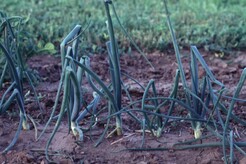 This is the time of year that onions grow and develop rapidly. Regular watering (if the soil ever dries out) and a light fertilization are helpful to maximize growth. If your soil tends to be alkaline, use ammonium sulfate (21-0-0) at the rate of ½ cup per 10 feet of row. Or you can use a lawn fertilizer such as a 29-5-5, 27-3-3 or anything similar but only use 1/3 cup per 10 feet of row. Make sure the lawn fertilizer does not have a weed preventer or weed killer included. Sprinkle the fertilizer 2 to 3 inches alongside the row and water in. Do not fertilize after the onions start to bulb. Onions develop so that as much as 2/3 of the bulb remains out of the soil. There is normal and there is no need to cover the bulb with soil. (Ward Upham) 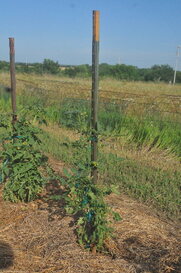 Soils are warm enough now that tomatoes can benefit from mulching as long as the soils are not saturated with water. Tomatoes prefer even levels of soil moisture and mulches provide such by preventing excessive evaporation. Other benefits of mulching include weed suppression, moderating soil temperatures and preventing the formation of a hard crust on the soil. Crusted soils restrict air movement into and out of the soil and slow the water infiltration rate. Hay and straw mulches are very popular for tomatoes but may contain weed or volunteer grain seeds. Grass clippings can also be used but should be applied as a relatively thin layer – only 2 to 3 inches thick. Clippings should also be dry as wet clipping can mold and become so hard that water can’t pass through. Also, do not use clippings from lawns that have been treated with a weed killer until some time has passed. With most types of weed killers, clippings from the fourth mowing after treatment may be used. If the lawn was treated with a product containing quinclorac (Drive), the clippings should not be used as mulch. If the weed killer used has a crabgrass killer, it likely contains quinclorac. (Ward Upham) 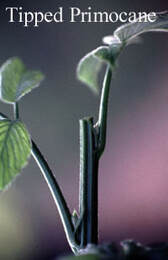 The growth and fruiting habits of blackberries and raspberries are the same. The root system is perennial, surviving many years, but canes are biennial and only live two years. First-year canes are called primocanes. They emerge from the soil and grow but with most varieties, the primocanes do not fruit. Primocanes become floricanes the second year. Floricanes fruit and then die. Each cane lives only two years. Pinching (tipping) the top 2 to 3 inches of the primocanes increases branching and fruiting. Tipping can improve yield by 3 to 5 times and is vital is you wish to have good yields. The height and frequency of tipping varies with species and whether the variety fruits on primocanes or not. Those that do fruit on primocanes are often referred to as “everbearing.” Those that only produce fruit the second year, we will call “traditional.” Below is a listing of the different methods used. Blackberries: Traditional - Tip at 4 feet Blackberries: Everbearing - Tip at 25 to 30 inches high. Laterals are also tipped when they reach 25 to 30 inches. Black Raspberries - Tip at 3 feet Purple Raspberries - Tip at 36 to 40 inches Red Raspberries - Do not tip. (Ward Upham) 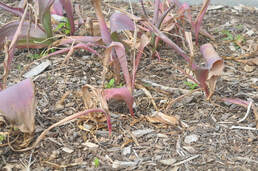 It is important to leave spring-flowering bulb foliage in place until it “ripens” or becomes brown. The energy produced by the leaves after flowering is transferred to the bulb so that it can flower the following year. The ripening process should be near completion now for tulips, daffodils and various other spring-flowering bulbs. Use clippers, scissors or even a mower to remove dead foliage. Also, try to map out where the bulbs are planted as there will be no foliage to make the location next fall when it is time to fertilize. (Ward Upham) 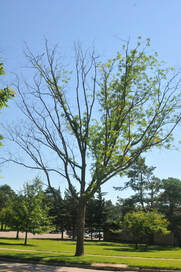 There have been a number of plants that have either died over winter or been slow to leaf out. In some cases, this is likely due to accumulated stress. We often think of plants reacting to stress that happened during the current season or possibly the previous year but it may not be that simple. I think this all started during the winter of 2017 - 2018. Many areas of Kansas had virtually no rain or snow from November through most of April during that winter. This put plants under a tremendous amount of stress. Plants under stress often react by setting an abnormal number of fruit buds. This helps insure the survival of the species even if the parent plant dies. So lots of fruit buds were set during 2018. Those buds matured into flower and then fruit (seeds) during 2019. Think back to last year. I have never seen certain plants bloom as well as they did last year. Maturing this much fruit takes a great deal of energy. I think this resulted in such low energy levels in the fall that the plants just didn’t have enough energy to make it through the winter or may have delayed leaf out. Areas with too much rain last summer had that additional stress added to the mix. Roots need oxygen as well as water and too much rain can damage root systems. So what do we do? The only thing we can do now is try to avoid any further stress. Basically that means watering during dry weather. Don’t overdo it as too much moisture can damage root systems. The goal is to keep the soil moist but not waterlogged while allowing the top of the soil surface to dry between waterings. (Ward Upham) 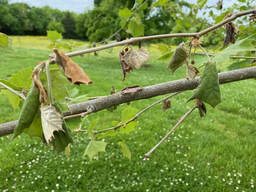 We are starting to see anthracnose on sycamore. Sycamore anthracnose is a fungal disease favored by cool, wet weather. Young leaves may wither and turn black. On older leaves, look for brown areas that follow the major veins of the leaves. In some cases, the petiole (leaf stem) is infected, which causes leaf drop. The leaf may look perfectly fine, so look for browned areas on the petiole. In severe cases, the tree drops heavily infected leaves and may be completely defoliated. We have had people cut down sycamore trees that have lost all their leaves. DO NOT DO THIS. Healthy trees will releaf in a few weeks. Defoliation this early in the year does not affect overall tree health. Trees have plenty of time to produce new leaves and make the energy reserves needed to survive the winter. Other types of trees that are affected by anthracnose include birch, elm, walnut, oak and especially ash. Anthracnose seldom causes significant damage to trees in Kansas, so chemical controls are usually unnecessary. Also, fungicides do not cure infected leaves. Applying fungicides after symptoms are seen will not help. (Ward Upham) We had a report last week from southeast Kansas that a number of ash trees have ash sawfly larvae feeding on the leaves.
These sawfly larvae are a light green color with a broad, whitish stripe on the top side. In the middle of the whitish stripe there appears to be a darker green stripe that is actually the digestive tract of the insect. Though sawfly larvae resemble caterpillars, they have at least six pairs of "stublike" prolegs behind the three pairs of true legs on their abdomen. Caterpillars never have more than five pairs of prolegs. There are usually no detrimental effects to the health of the tree if nature is allowed to run its course. Even if all the leaves are eaten, it is early enough in the growing season for trees to put out a complete new set of leaves with enough time to make all the food reserves needed to survive the coming winter. However, if control is desired, a number of insecticides may be used for control including cyfluthrin (BioAdvanced Lawn and Garden Multi-Insect Killer), malathion, and esfenvalerate (Monterey Bug Buster II). An effective organic product is spinosad (Captain Jack’s Deadbug Brew; Natural Guard Spinosad, Monterey Garden Insect Spray). Horticultural oils and insecticidal soaps are also effective because of the soft skin of sawfly larvae. (Ward Upham) 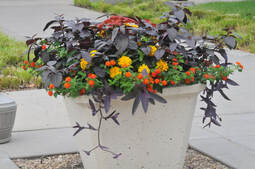 I have had several questions this spring on potting soils and how to choose the best potting media. Dr. Cheryl Boyer, our Nursery Crop and Marketing Specialist, has done extensive studies on potting soils and has written the following to help homeowners make a good choice. We will present her material is three parts or steps with one step each week. Step 1: What are You Using it For? Step 2: Understanding Major, Minor, and Specialty Components Step 3: Mixing and Managing Last week we covered Step 1. So, here is Step 2. (Ward Upham) Step 2: Understanding Major, Minor, and Specialty Components These materials are regionally sourced and often composted to reduce particle size. Some materials are manufactured for the purpose of being used in potting media and many more are by-products of other industries. They are all fine as components but look at the label to understand how much of each “ingredient” is mixed, by volume, into the product you’re purchasing. If that information isn’t on the bag, be wary of purchasing. · Major components: Bark (or “composted forest products”), peat (this might be defined by type of peat which often refers to the source material or the coarseness), soil (don’t pay for this unless it’s local/regional and advertised as a single-component soil amendment—not as a potting media), manure, sand. Other waste-product alternative materials such as coconut coir and wood fiber are also great to use, but they’re not seen as often in consumer-level products. · Minor components: Perlite (little white pellets--it’s for aeration, not fertilization), vermiculite (shiny heat-expanded rock pieces), rice hulls (also for aeration with an added bonus of weed control when applied to the tops of containers). These are the most common. · Specialty components: mycorrhizae (symbiotic fungal organism that, mixed in, can be very beneficial in a container system by expanding the root capacity to take up nutrients and water, it’s less effective in field soil where these organisms are already abundant), fungicide (some products are designed to address specific fungal growth issues). A note about manure and compost: These are good organic materials; however, you must be careful that the source can guarantee the material that produced the manure (hay, pasture grass, etc.) was not treated with herbicide. Many herbicides used in pasture management have a very long half-life and can persist in your landscape beds, killing desired plants. A note about organic products: While most media components are considered “natural” and are likely produced using organic practices, few will be labeled as organic simply due to the nature of the organic certification process. An organically labeled product is not inherently better than another, though if you’re looking for a bagged manure product, organic will ensure the absence of herbicide residue. (Cheryl Boyer) 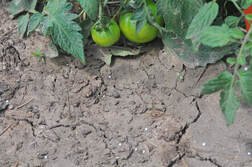 Gregg Eyestone, Horticulture Agent from Riley County, has put together a nice chart that covers sidedressing nitrogen on annual flowers, certain perennial flowers, vegetables and various small fruit. Sidedressing (also called topdressing) is applying nitrogen fertilizer as plants are growing to give them an extra boost. Done correctly, sidedressing can improve vegetable, fruit and flower production. This will be especially important this year in areas that have received excessive rainfall as nitrogen has likely been lost. Gregg lists the crop, the amount of fertilizer needed, and suggested time of application. Rates are given for ammonium sulfate, urea and blood meal. You may find the chart at http://tinyurl.com/hxtgres (Ward Upham) |
AuthorsCynthia Domenghini runs the Horticulture Response Center in the Department of Horticulture and Natural Resources at Kansas State University. Other contributors include K-State Extension Specialists. Archives
March 2024
Categories
All
|
| K-State Research and Extension Horticulture Newsletter |
|
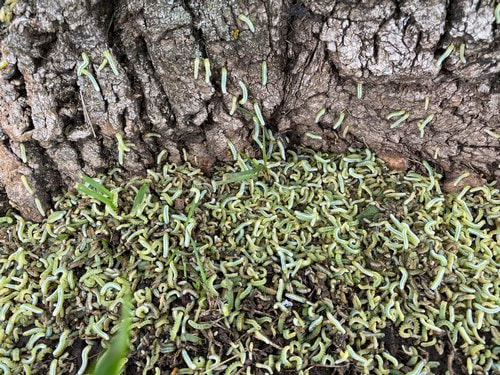
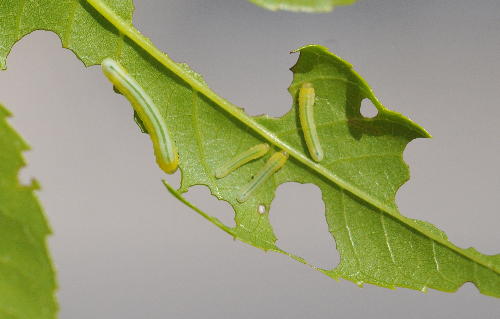
 RSS Feed
RSS Feed
